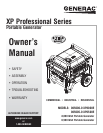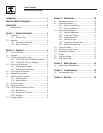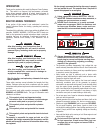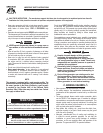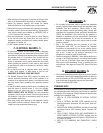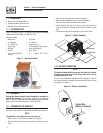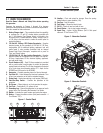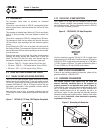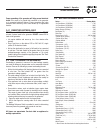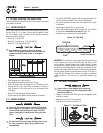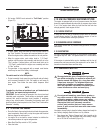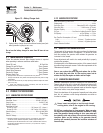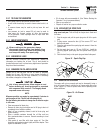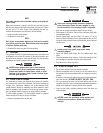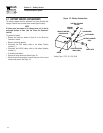
When working on this equipment, remain alert at all times. Never •
work on the equipment when physically or mentally fatigued.
Inspect the generator regularly, and contact the nearest •
Authorized Dealer for parts needing repair or replacement.
Before performing any maintenance on the generator, disconnect •
its battery cables to prevent accidental start up. Disconnect the
cable from the battery post indicated by a NEGATIVE, NEG or
(–) first. Reconnect that cable last.
Never use the generator or any of its parts as a step. Stepping •
on the unit can stress and break parts, and may result in
dangerous operating conditions from leaking exhaust gases,
fuel leakage, oil leakage, etc.
Do NOT operate generator in the rain.•
ELECTRICAL HAZARDS
All generators covered by this manual produce dangerous •
electrical voltages and can cause fatal electrical shock. Utility
power delivers extremely high and dangerous voltages as does
the generator when it is in operation. Avoid contact with bare
wires, terminals, connections, etc., while the unit is running.
Ensure all appropriate covers, guards and barriers are in place
before operating the generator. If work must be done around
an operating unit, stand on an insulated, dry surface to reduce
shock hazard.
Do not handle any kind of electrical device while standing •
in water, while barefoot, or while hands or feet are wet.
DANGEROUS ELECTRICAL SHOCK MAY RESULT.
The National Electrical Code (NEC) requires the frame and •
external electrically conductive parts of the generator to be
connected to an approved earth ground. Local electrical codes
also may require proper grounding of the generator electrical
system.
In case of accident caused by electric shock, immediately shut •
down the source of electrical power. If this is not possible,
attempt to free the victim from the live conductor. AVOID
DIRECT CONTACT WITH THE VICTIM. Use a non-conducting
implement, such as a rope or board, to free the victim from the
live conductor. If the victim is unconscious, apply first aid and
get immediate medical help.
Never wear jewelry when working on this equipment. Jewelry •
can conduct electricity resulting in electric shock, or may get
caught in moving components causing injury.
FIRE HAZARDS
For fire safety, the generator must be operated and maintained •
properly. Operation must always comply with applicable codes,
standards, laws and regulations. Adhere strictly to local,
state and national electrical and building codes. Comply with
regulations the Occupational Safety and Health Administration
(OSHA) has established. Also, ensure that the generator is
operated in accordance with the manufacturer’s instructions
and recommendations. Do not alter the construction of the
generator or change controls which might create an unsafe
operating condition.
Keep a fire extinguisher near the generator at all times. •
Extinguishers rated “ABC” by the National Fire Protection
Association are appropriate for use on the standby electric
system. Keep the extinguisher properly charged and be familiar
with its use. If there are any questions pertaining to fire
extinguishers, consult the local fire department.
Gasoline is extremely FLAMMABLE. Never add fuel while unit is •
running or hot. Allow engine/unit to cool entirely before adding
fuel. Do not over fill fuel tank. Allow room for fuel expansion.
Wipe up fuel spills immediately. If tank is overfilled, fuel can
overflow onto a hot engine and cause FIRE. Never fill fuel tank
indoors.
EXPLOSION HAZARDS
Do not smoke around the generator. Wipe up any fuel or oil spills •
immediately. Ensure that no combustible materials are left on or
near the generator, as FIRE or EXPLOSION may result. Keep the
area surrounding the generator clean and free from debris.
Gasoline is extremely EXPLOSIVE. •
STANDARDS INDEX
In the absence of pertinent standards, codes, regulations and laws,
the published information listed below may be used as a guideline
for operation of this equipment. Always reference the latest revision
available for the standards listed.
1. NFPA No. 70, NFPA HANDBOOK OF NATIONAL ELECTRIC
CODE.
2. Article X, NATIONAL BUILDING CODE, available from the
American Insurance Association, 85 John Street, New York,
N.Y. 10038.
3. AGRICULTURAL WIRING HANDBOOK, available from the Food
and Energy Council, 909 University Avenue, Columbia, MO
65201.
4. ASAE EP-3634, INSTALLATION AND MAINTENANCE OF
FARM STANDBY ELECTRICAL SYSTEMS, available from the
American Society of Agricultural Engineers, 2950 Niles Road,
St. Joseph, MI 49085.
5. NFPA No. 30, FLAMMABLE AND COMBUSTIBLE LIQUIDS
CODE.
3
IMPORTANT SAFETY INSTRUCTIONS
Portable Generator System



